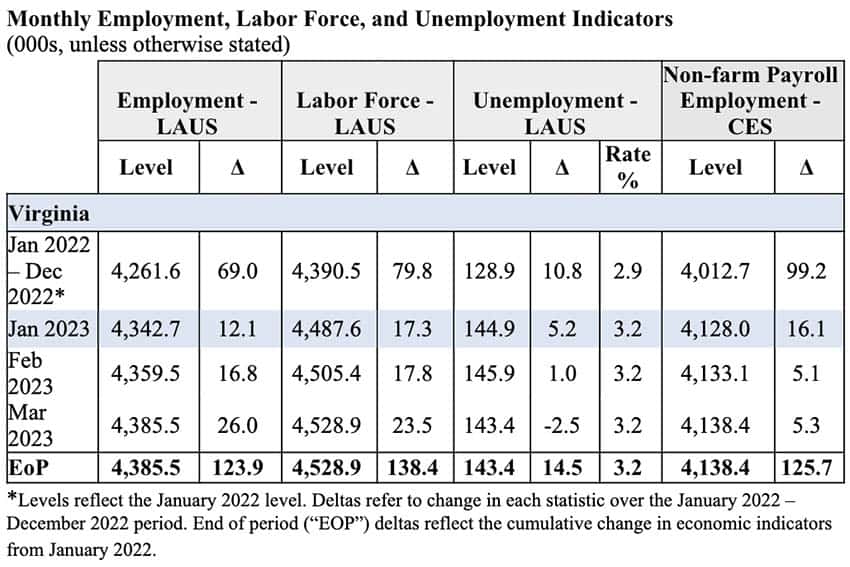Virginia’s Labor Force is at record high
Governor Glenn Youngkin today announced more than 4.52 million people in Virginia’s labor force—the most ever since first recorded in 1976. The labor force participation rate has increased to 65.9% in March, a rate higher than the February 2020 pre-pandemic rate of 65.7%. According to Bureau of Labor and Statistics Local Area Unemployment Statistics (“LAUS”, or “the household survey”), the labor force in Virginia increased this month by 23,511 to 4,528,910.
“Since day one, I have been laser-focused on more Virginians entering the workforce and today we reached new heights,” said Governor Glenn Youngkin. “Our approach to make Virginia more affordable for families and local businesses is working and we are pressing forward on commonsense policies to make Virginia even more competitive and bring more people into the labor force.”
With the increase of Virginians moving back into the workforce, Virginia’s unemployment rate of 3.2 percent was unchanged from February and remained below the national rate, which decreased to 3.5 percent in March.
According to LAUS, the number of employed Virginians increased by 25,941 to 4,385,463 in March. Throughout the month, the number of unemployed residents decreased by 2,430 to 143,447.
“The number of people in the Virginia labor force has reached an all-time high this month,” said Secretary of Labor Bryan Slater. “As more people join the labor force and search for employment, our workforce services are here to place them in jobs.”
“The labor force participation rate rose to 65.9% in March, which exceeds the 65.7% we saw in February of 2020.”said Secretary Caren Merrick. “The influx of Virginians looking for work tells employers of the Commonwealth that we can serve all of their workforce needs.”
BLS publishes an additional employment figure from its Current Employment Statistics Survey (“CES” or “establishment survey”). Virginia CES employment rose by 5,300 jobs in March to 4,138,400 and has increased by 99,900 since March 2022.
The CES survey uses payroll records of establishment employers and is designed to provide a count of jobs under which the employer pays unemployment insurance. The LAUS survey is based on household interviews conducted each month for the Bureau of Labor Statistics and provides comprehensive data on the labor force, including those who are employed and unemployed. Establishments are classified in an industry on the basis of their principal product or activity in accordance with the most recent North American Industry Classification System (NAICS) Manual.
The household survey only distinguishes between whether a person is employed or unemployed, whereas CES counts each employee that is on an employer’s payroll. CES excludes business owners, self-employed persons, unpaid volunteers and private household workers, and those on unpaid leave or not working because of a labor dispute.

On a seasonally adjusted basis, employment rose in six of eleven major industry sectors, held steady in Mining and Logging, and declined in four. The largest job gain during March occurred in Professional and Business Services (+3,500 jobs) to 815,900. The second largest increase was Education and Health Services (+2,200) jobs to 574,500. Government was third (+1,900) jobs, to 728,200. The largest decrease was in Trade, Transportation, and Utilities with a decrease of (-1,900) jobs to 666,000. The second largest decrease occurred in Construction (-1,400 jobs) to 213,100. The third largest loss occurred in Finance (-800 jobs) to 213,400.
Compared to a year ago, on a seasonally adjusted basis, nine of eleven major industry divisions experienced employment increases while one saw an employment decrease, and Mining and Logging held steady. The largest absolute over-the-year job gain occurred in Education and Health Services up 28,900 jobs (+5.3%). The second largest over-the-year job gain occurred in Leisure and Hospitality, up 24,100 jobs (+6.3%). The third largest over-the-year job gain occurred in Professional and Business Services up 18,300 jobs (+2.3%). The only job loss occurred in Finance, with a decrease of (-1,700) jobs. For more details, visit the Virginia Employment Commission’s website at vec.virginia.gov.









